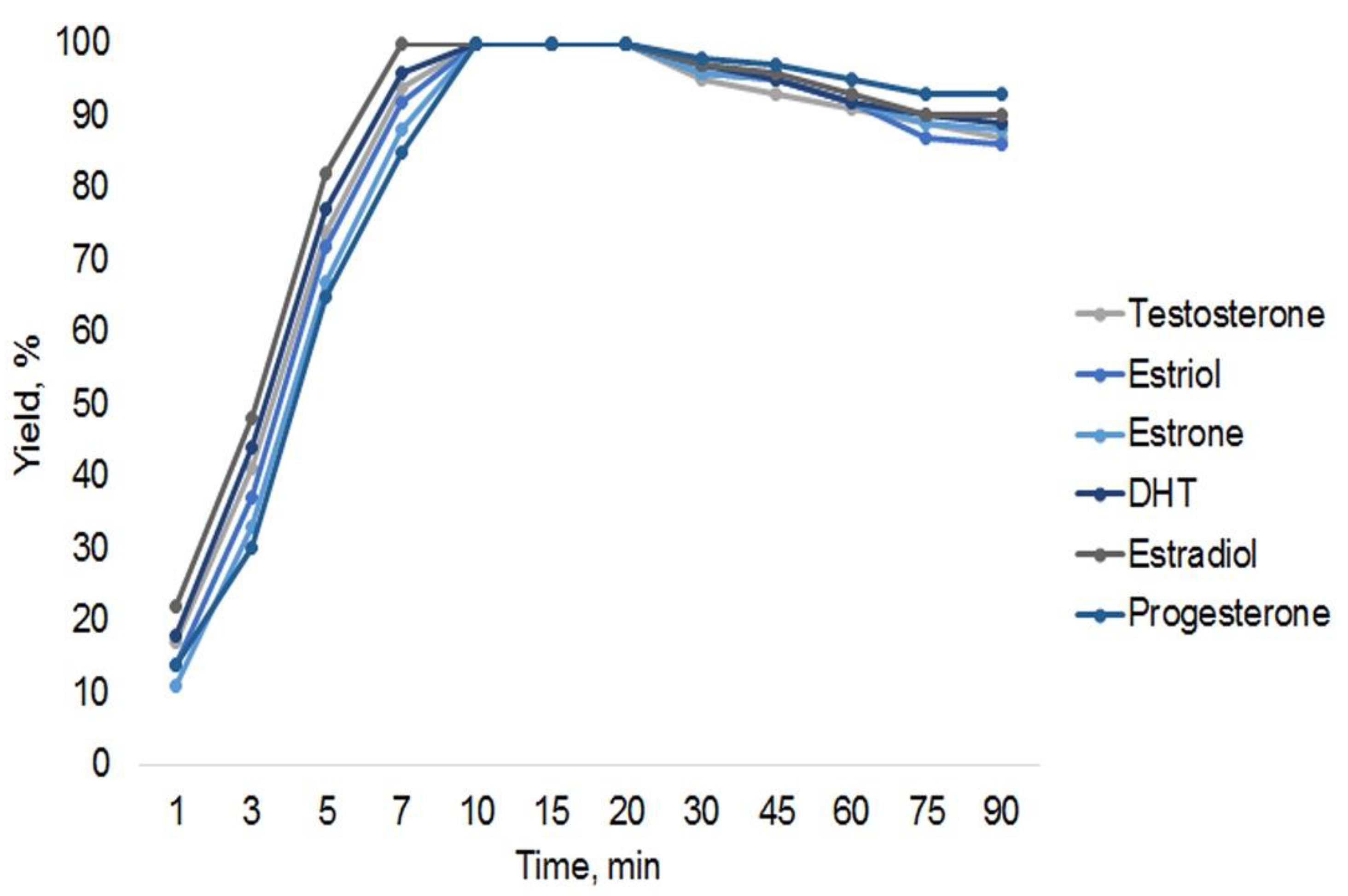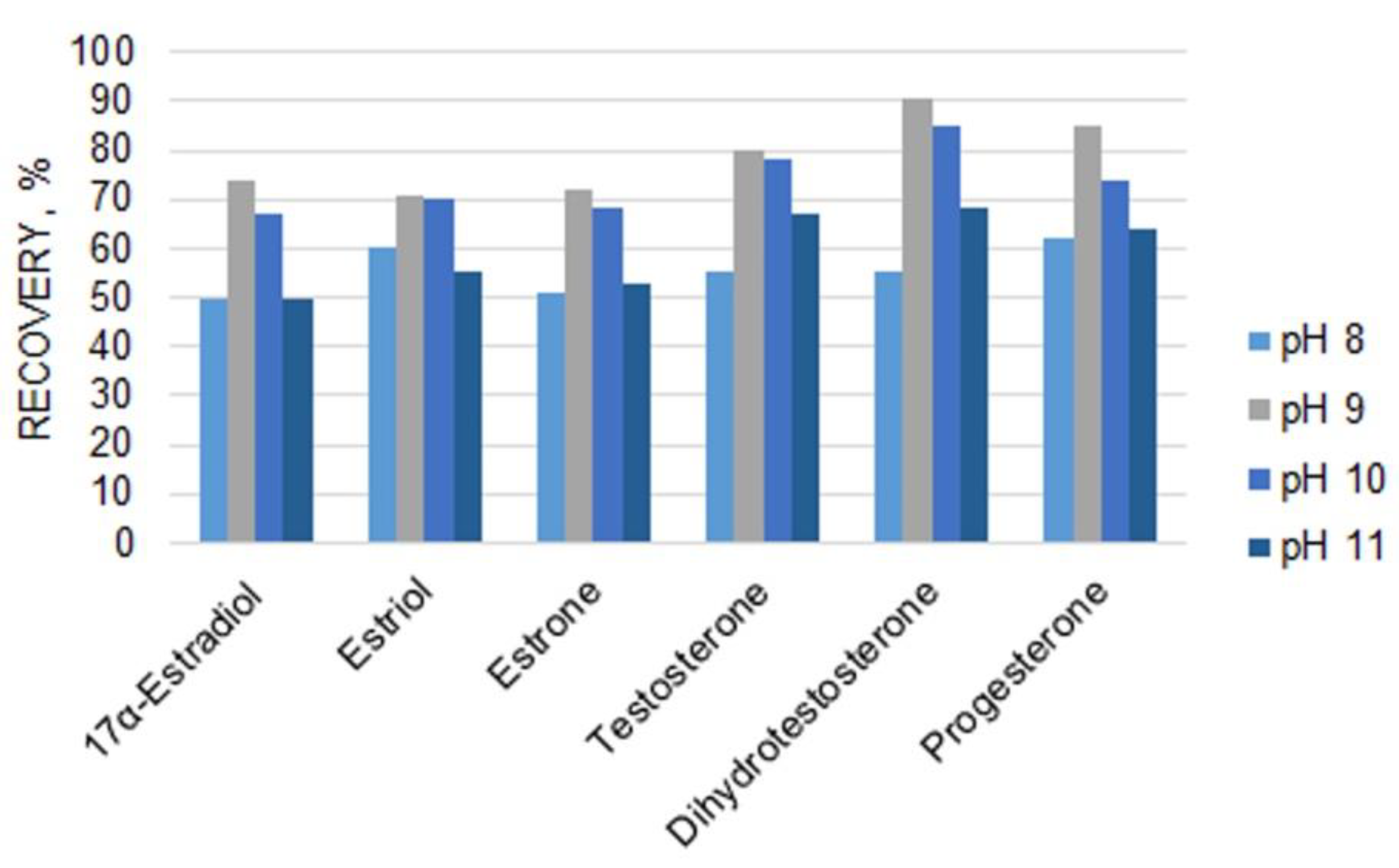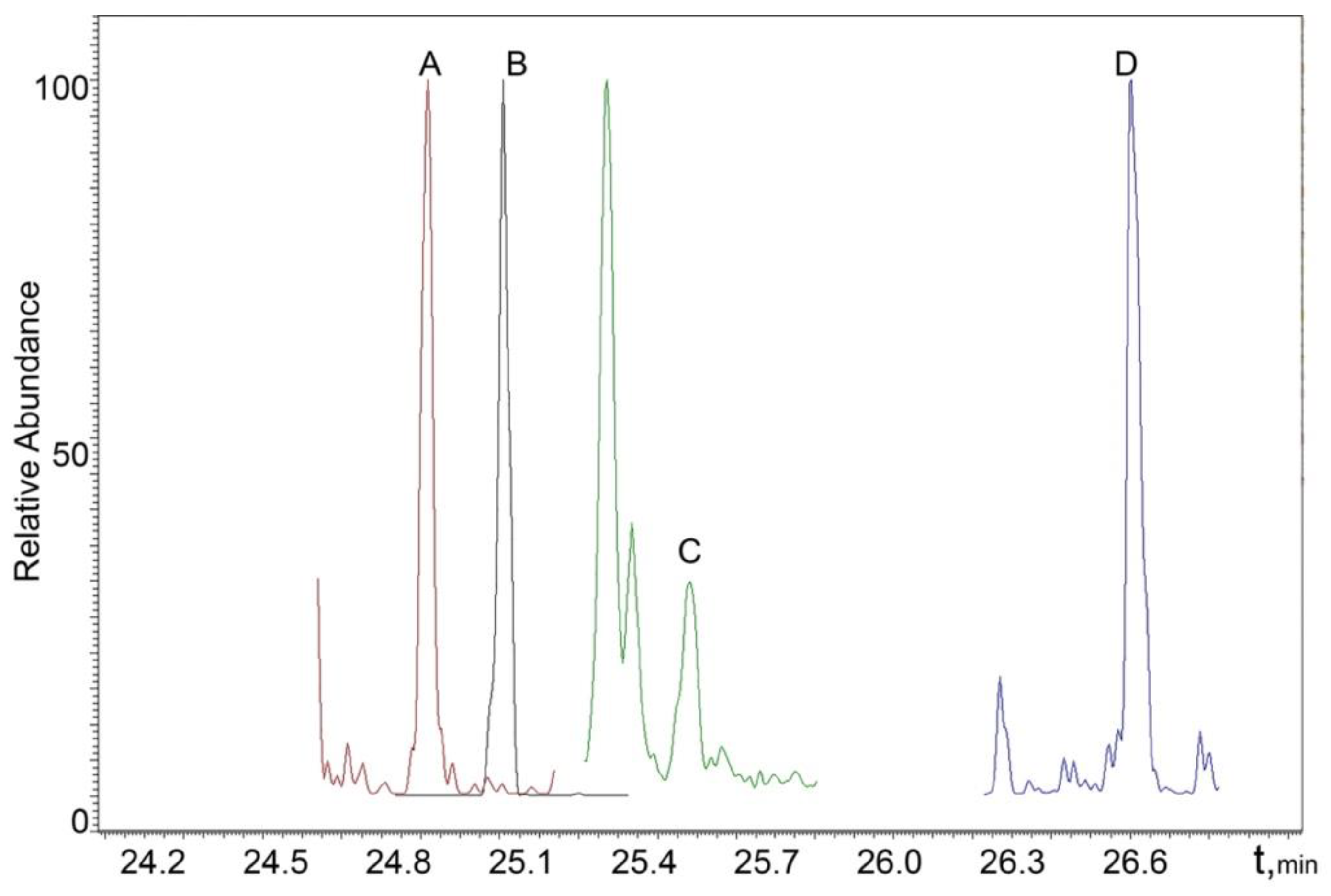GC-MS/MS Determination of Steroid Hormones in Urine Using Solid-Phase Derivatization as an Alternative to Conventional Methods
Abstract
:1. Introduction
2. Results
2.1. Optimization of Sample Preparation Conditions
2.2. Chromatographic Separation and Mass Spectrometric Detection Conditions
2.3. Analytical Figures of Merit of the Proposed Method
2.4. Analysis of Real Samples
3. Discussion
4. Materials and Methods
4.1. Chemicals
4.2. Preparation of Solutions
4.3. Urine Samples
4.4. Instrumentation
4.5. Liquid–liquid Extraction Procedure
4.6. Optimum Solid-Phase Analytical Derivatization Conditions
5. Conclusions
Author Contributions
Funding
Institutional Review Board Statement
Informed Consent Statement
Data Availability Statement
Conflicts of Interest
Sample Availability
References
- Yuan, T.-F.; Le, J.; Wang, S.-T.; Li, Y. An LC/MS/MS Method for Analyzing the Steroid Metabolome with High Accuracy and from Small Serum Samples[S]. J. Lipid Res. 2020, 61, 580–586. [Google Scholar] [CrossRef]
- WADA Technical Document-TD2021EAAS Document Number: TD2021EAAS Version Number: 2.0 (2021):1–11. Available online: https://www.wada-ama.org/sites/default/files/resources/files/td2021eaas_final_eng_v_2.0.pdf (accessed on 23 August 2022).
- De Wilde, L.; Roels, K.; Van Renterghem, P.; Van Eenoo, P.; Deventer, K. Steroid Profiling in Urine of Intact Glucuronidated and Sulfated Steroids Using Liquid Chromatography-Mass Spectrometry. J. Chromatogr. A 2020, 1624, 461231. [Google Scholar] [CrossRef]
- Van Renterghem, P.; Viaene, W.; Van Gansbeke, W.; Barrabin, J.; Iannone, M.; Polet, M.; T’Sjoen, G.; Deventer, K.; Van Eenoo, P. Validation of an Ultra-Sensitive Detection Method for Steroid Esters in Plasma for Doping Analysis Using Positive Chemical Ionization GC-MS/MS. J. Chromatogr. B 2020, 1141, 122026. [Google Scholar] [CrossRef]
- Gomez-Gomez, A.; Miranda, J.; Feixas, G.; Arranz Betegon, A.; Crispi, F.; Gratacós, E.; Pozo, O.J. Determination of the Steroid Profile in Alternative Matrices by Liquid Chromatography Tandem Mass Spectrometry. J. Steroid Biochem. Mol. Biol. 2020, 197, 105520. [Google Scholar] [CrossRef]
- Nara, S.; Tripathi, V.; Chaube, S.K.; Rangari, K.; Singh, H.; Kariya, K.P.; Shrivastav, T.G. Influence of Hydrophobic and Hydrophilic Spacer-Containing Enzyme Conjugates on Functional Parameters of Steroid Immunoassay. Anal. Biochem. 2008, 373, 18–25. [Google Scholar] [CrossRef]
- Fanelli, F.; Belluomo, I.; Di Lallo, V.D.; Cuomo, G.; De Iasio, R.; Baccini, M.; Casadio, E.; Casetta, B.; Vicennati, V.; Gambineri, A.; et al. Serum Steroid Profiling by Isotopic Dilution-Liquid Chromatography–Mass Spectrometry: Comparison with Current Immunoassays and Reference Intervals in Healthy Adults. Steroids 2011, 76, 244–253. [Google Scholar] [CrossRef]
- Herold, D.A.; Fitzgerald, R.L. Immunoassays for Testosterone in Women: Better than a Guess? Clin. Chem. 2003, 49, 1250–1251. [Google Scholar] [CrossRef] [PubMed]
- Cao, Y.; McDermott, M.T. A Surface Plasmon Resonance Based Inhibition Immunoassay for Measurement of Steroid Hormones. Anal. Biochem. 2018, 557, 7–12. [Google Scholar] [CrossRef] [PubMed]
- Chung, B.; Choo, H.-Y.P.; Kim, T.; Eom, K.; Kwon, O.; Suh, J.; Yang, J.; Park, J. Analysis of Anabolic Steroids Using GC/MS with Selected Ion Monitoring. J. Anal. Toxicol. 1990, 14, 91–95. [Google Scholar] [CrossRef] [PubMed]
- Bowden, J.A.; Colosi, D.M.; Mora-Montero, D.C.; Garrett, T.J.; Yost, R.A. Enhancement of Chemical Derivatization of Steroids by Gas Chromatography/Mass Spectrometry (GC/MS). J. Chromatogr. B 2009, 877, 3237–3242. [Google Scholar] [CrossRef]
- Krone, N.; Hughes, B.A.; Lavery, G.G.; Stewart, P.M.; Arlt, W.; Shackleton, C.H.L. Gas Chromatography/Mass Spectrometry (GC/MS) Remains a Pre-Eminent Discovery Tool in Clinical Steroid Investigations Even in the Era of Fast Liquid Chromatography Tandem Mass Spectrometry (LC/MS/MS). J. Steroid Biochem. Mol. Biol. 2010, 121, 496–504. [Google Scholar] [CrossRef]
- Ahmadkhaniha, R.; Shafiee, A.; Rastkari, N.; Khoshayand, M.R.; Kobarfard, F. Quantification of Endogenous Steroids in Human Urine by Gas Chromatography Mass Spectrometry Using a Surrogate Analyte Approach. J. Chromatogr. B 2010, 878, 845–852. [Google Scholar] [CrossRef]
- Hansen, M.; Jacobsen, N.W.; Nielsen, F.K.; Björklund, E.; Styrishave, B.; Halling-Sørensen, B. Determination of Steroid Hormones in Blood by GC–MS/MS. Anal. Bioanal Chem. 2011, 400, 3409–3417. [Google Scholar] [CrossRef] [PubMed]
- Toledano, R.M.; Díaz-Plaza, E.M.; Cortés, J.M.; Blázquez, I.; Vázquez, A.; Villén, J.; Muñoz-Guerra, J. Analysis of Steroids in Human Urine by on Line Liquid Chromatography–Gas Chromatography–Mass Spectrometry Using the Through Oven Transfer Adsorption Desorption Interface and a Fraction Collector. Anal. Chim. Acta 2012, 741, 78–85. [Google Scholar] [CrossRef]
- Christakoudi, S.; Cowan, D.A.; Taylor, N.F. Steroids Excreted in Urine by Neonates with 21-Hydroxylase Deficiency. 2. Characterization, Using GC–MS and GC–MS/MS, of Pregnanes and Pregnenes with an Oxo-Group on the A- or B-Ring. Steroids 2012, 77, 382–393. [Google Scholar] [CrossRef]
- Bai, Y.-L.; Hong, Z.-D.; Zhang, T.-Y.; Cai, B.-D.; Zhang, Y.-Z.; Feng, Y.-Q. A Method for Simultaneous Determination of 14 Carbonyl-Steroid Hormones in Human Serum by Ultra High Performance Liquid Chromatography–Tandem Mass Spectrometry. J. Anal. Test. 2020, 4, 1–12. [Google Scholar] [CrossRef]
- Matysik, S.; Schmitz, G. Determination of Steroid Hormones in Human Plasma by GC–Triple Quadrupole MS. Steroids 2015, 99, 151–154. [Google Scholar] [CrossRef]
- Davis, D.E., Jr.; Leaptrot, K.L.; Koomen, D.C.; May, J.C.; Cavalcanti, G.D.A.; Padilha, M.C.; Pereira, H.M.; McLean, J.A. Multidimensional Separations of Intact Phase II Steroid Metabolites Utilizing LC–Ion Mobility–HRMS. Anal. Chem. 2021, 93, 10990–10998. [Google Scholar] [CrossRef] [PubMed]
- Arthur, K.L.; Turner, M.A.; Brailsford, A.D.; Kicman, A.T.; Cowan, D.A.; Reynolds, J.C.; Creaser, C.S. Rapid Analysis of Anabolic Steroid Metabolites in Urine by Combining Field Asymmetric Waveform Ion Mobility Spectrometry with Liquid Chromatography and Mass Spectrometry. Anal. Chem. 2017, 89, 7431–7437. [Google Scholar] [CrossRef]
- Hernández-Mesa, M.; Le Bizec, B.; Monteau, F.; García-Campaña, A.M.; Dervilly-Pinel, G. Collision Cross Section (CCS) Database: An Additional Measure to Characterize Steroids. Anal. Chem. 2018, 90, 4616–4625. [Google Scholar] [CrossRef] [PubMed]
- Gomes, R.L.; Meredith, W.; Snape, C.E.; Sephton, M.A. Analysis of Conjugated Steroid Androgens: Deconjugation, Derivatisation and Associated Issues. J. Pharm. Biomed. Anal. 2009, 49, 1133–1140. [Google Scholar] [CrossRef]
- Buiarelli, F.; Coccioli, F.; Merolle, M.; Neri, B.; Terracciano, A. Development of a Liquid Chromatography–Tandem Mass Spectrometry Method for the Identification of Natural Androgen Steroids and Their Conjugates in Urine Samples. Anal. Chim. Acta 2004, 526, 113–120. [Google Scholar] [CrossRef]
- Pizzato, E.C.; Filonzi, M.; Rosa, H.S.D.; de Bairros, A.V. Pretreatment of Different Biological Matrices for Exogenous Testosterone Analysis: A Review. Null 2017, 27, 641–656. [Google Scholar] [CrossRef]
- Escobar-Wilches, D.C.; Ventura-Bahena, A.; de Lourdes López-González, M.; Torres-Sánchez, L.; Figueroa, M.; Sierra-Santoyo, A. Analysis of Testosterone-Hydroxylated Metabolites in Human Urine by Ultra High Performance Liquid Chromatography-Mass Spectrometry. Anal. Biochem. 2020, 597, 113670. [Google Scholar] [CrossRef]
- El-Deen, A.K.; Shimizu, K. Deep Eutectic Solvent as a Novel Disperser in Dispersive Liquid-Liquid Microextraction Based on Solidification of Floating Organic Droplet (DLLME-SFOD) for Preconcentration of Steroids in Water Samples: Assessment of the Method Deleterious Impact on the Environment Using Analytical Eco-Scale and Green Analytical Procedure Index. Microchem. J. 2019, 149, 103988. [Google Scholar] [CrossRef]
- Dmitrieva, E.; Temerdashev, A.; Azaryan, A.; Gashimova, E. Quantification of Steroid Hormones in Human Urine by DLLME and UHPLC-HRMS Detection. J. Chromatogr. B 2020, 1159, 122390. [Google Scholar] [CrossRef]
- Zong, Y.; Chen, J.; Hou, J.; Deng, W.; Liao, X.; Xiao, Y. Hexafluoroisopropanol-Alkyl Carboxylic Acid High-Density Supramolecular Solvent Based Dispersive Liquid-Liquid Microextraction of Steroid Sex Hormones in Human Urine. J. Chromatogr. A 2018, 1580, 12–21. [Google Scholar] [CrossRef] [PubMed]
- Márta, Z.; Bobály, B.; Fekete, J.; Magda, B.; Imre, T.; Mészáros, K.V.; Bálint, M.; Szabó, P.T. Simultaneous Determination of Thirteen Different Steroid Hormones Using Micro UHPLC-MS/MS with on-Line SPE System. J. Pharm. Biomed. Anal. 2018, 150, 258–267. [Google Scholar] [CrossRef]
- Moon, J.-Y.; Lee, H.S.; Kim, J.H.; Lee, J.H.; Choi, M.H. Supported Liquid Extraction Coupled to Gas Chromatography-Selective Mass Spectrometric Scan Modes for Serum Steroid Profiling. Anal. Chim. Acta 2018, 1037, 281–292. [Google Scholar] [CrossRef]
- Tölgyesi, Á.; Barta, E.; Simon, A.; McDonald, T.J.; Sharma, V.K. Screening and Confirmation of Steroids and Nitroimidazoles in Urine, Blood, and Food Matrices: Sample Preparation Methods and Liquid Chromatography Tandem Mass Spectrometric Separations. J. Pharm. Biomed. Anal. 2017, 145, 805–813. [Google Scholar] [CrossRef]
- Dévier, M.-H.; Labadie, P.; Togola, A.; Budzinski, H. Simple Methodology Coupling Microwave-Assisted Extraction to SPE/GC/MS for the Analysis of Natural Steroids in Biological Tissues: Application to the Monitoring of Endogenous Steroids in Marine Mussels Mytilus sp. Anal. Chim. Acta 2010, 657, 28–35. [Google Scholar] [CrossRef] [PubMed]
- Dmitrieva, E.V.; Temerdashev, A.Z.; Zorina, M.O.; Feng, Y.-Q.; Nesterenko, P.N. Solid-Phase Analytical Derivatization as a Tool for the Quantification of Steroid Hormones in Human Urine with HPLC-Q-ToF Detection. J. Pharm. Biomed. Anal. 2022, 214, 114736. [Google Scholar] [CrossRef]
- Gaikwad, N.W. Ultra Performance Liquid Chromatography-Tandem Mass Spectrometry Method for Profiling of Steroid Metabolome in Human Tissue. Anal. Chem. 2013, 85, 4951–4960. [Google Scholar] [CrossRef]
- Fabregat, A.; Pozo, O.J.; Marcos, J.; Segura, J.; Ventura, R. Use of LC-MS/MS for the Open Detection of Steroid Metabolites Conjugated with Glucuronic Acid. Anal. Chem. 2013, 85, 5005–5014. [Google Scholar] [CrossRef]
- Martinez-Brito, D.; Notarianni, M.L.; Iannone, M.; de la Torre, X.; Botrè, F. Validation of Steroid Sulfates Deconjugation for Metabolic Studies. Application to Human Urine Samples. J. Pharmacol. Toxicol. Methods 2020, 106, 106938. [Google Scholar] [CrossRef]
- Liu, W.; Yuan, D.; Han, M.; Huang, J.; Xie, Y. Development and Validation of a Sensitive LC-MS/MS Method for Simultaneous Quantification of Thirteen Steroid Hormones in Human Serum and Its Application to the Study of Type 2 Diabetes Mellitus. J. Pharm. Biomed. Anal. 2021, 199, 114059. [Google Scholar] [CrossRef]
- Wang, R.; Hartmann, M.F.; Wudy, S.A. Targeted LC–MS/MS Analysis of Steroid Glucuronides in Human Urine. J. Steroid Biochem. Mol. Biol. 2021, 205, 105774. [Google Scholar] [CrossRef]
- Atapattu, S.N.; Rosenfeld, J.M. Micro Scale Analytical Derivatizations on Solid Phase. TrAC Trends Anal. 2019, 113, 351–356. [Google Scholar] [CrossRef]
- Atapattu, S.N.; Rosenfeld, J.M. Solid Phase Analytical Derivatization. Reference Module in Chemistry, Molecular Sciences and Chemical Engineering; Elsevier: Oxford, UK, 2018; ISBN 978-0-12-409547-2. [Google Scholar]
- Sobolevsky, T.; Krotov, G.; Dikunets, M.; Nikitina, M.; Mochalova, E.; Rodchenkov, G. Anti-Doping Analyses at the Sochi Olympic and Paralympic Games 2014. Drug Test. Anal. 2014, 6, 1087–1101. [Google Scholar] [CrossRef]




| Analyte | Matrix | Sample Preparation | Method | LOQ (LOD), ng/mL | Reference |
|---|---|---|---|---|---|
| 101 steroids | Tissue | Homogenization of 100 mg of the sample, centrifugation followed by lyophilization and dissolving in 150 µL of water–methanol (1:1) mixture | UHPLC-MS/MS (QqQ, ESI) | 0.5–500 | [34] |
| 13 steroid glucuronides | Artificial urine | Enzymatic hydrolysis, SPE clean-up, evaporation, residue dissolution | UHPLC-MS/MS (QqQ, ESI) | 1–500 | [35] |
| 7 steroids | Urine | Alkaline hydrolysis, LLE (MTBE), derivatization with MSTFA/DTT/NH4I mixture | GC-MS | 1–4 | [36] |
| 13 steroids | Serum | LLE with ethyl acetate–n-hexane, incubation in ice for 10 min, centrifugation, evaporation, residue reconstruction | UHPLC-MS/MS (QqQ, ESI) | 0.08–7.81 | [37] |
| 4 steroids | Urine | Protein precipitation with acetonitrile, SPE, evaporation and residue reconstruction | UHPLC-MS/MS (QqQ, ESI) | 1.9–21.4 nmol/L | [38] |
| Analyte | Precursor Ion, m/z | Product Ion, m/z | Collision Energy, eV | tR, min |
|---|---|---|---|---|
| 17α-Estradiol | 416.3 | 232.3 | 20 | 24.84 |
| 284.8 * | 10 | |||
| 326.8 | 5 | |||
| Estrone | 414.3 | 231.2 * | 30 | 25.03 |
| 283.4 | 25 | |||
| 399.9 | 15 | |||
| Dihydrotestosterone | 434.3 | 168.6 | 15 | 25.17 |
| 195.3 * | 30 | |||
| 291.2 | 20 | |||
| Testosterone | 432.3 | 168.8 | 25 | 25.51 |
| 403.8 | 15 | |||
| 417.5 * | 10 | |||
| Methyltestosterone (IS) | 446.4 | 195.0 | 30 | 26.53 |
| 301.1 * | 20 | |||
| 356.4 | 10 | |||
| Estriol | 504.4 | 414.2 | 10 | 27.60 |
| 311.1 * | 15 | |||
| 255.0 | 30 | |||
| Progesterone | 458.4 | 157.0 | 15 | 27.88 |
| 208.1 | 25 | |||
| 443.4 * | 10 |
| Procedure | Advantages | Disadvantages |
|---|---|---|
| Liquid–liquid extraction | Cost-effective; High solvent capacity; Easy to use | Requires toxic solvents; Time-consuming; pH-dependent character of extraction efficiency |
| Solid-phase extraction | Quick; Easy to use; Can be partially automated | Expensive; Requires toxic solvents; Sorbent capacity evaluation is required before analysis; Losses of analytes if solvent is evaporated after elution |
| Solid-phase analytical derivatization | Quick; Easy to use; Time-effective; Can be fully automated | Expensive; Sorbent capacity evaluation is required before analysis |
| Analyte | LOD, ng/mL | LOQ, ng/mL | Linear Range, ng/mL | R2 |
|---|---|---|---|---|
| 17α-Estradiol | 2.5 | 5 | 5–100 | 0.995 |
| Estrone | 2.5 | 5 | 5–100 | 0.993 |
| Dihydrotestosterone | 1.0 | 2.5 | 2.5–100 | 0.996 |
| Testosterone | 1.0 | 2.5 | 2.5–100 | 0.997 |
| Estriol | 1.0 | 2.5 | 2.5–100 | 0.995 |
| Progesterone | 2.5 | 5 | 5–100 | 0.998 |
| Parameter | SPAD | LLE |
|---|---|---|
| Sensitivity (LOQ), ng/mL | 2.5–5 | 1.0–2.5 |
| Sample preparation time, min | 60 (including 40 min of enzymatic hydrolysis) | 180 (including 40 min of enzymatic hydrolysis) |
| Recovery, % | 92–95 | 65–90 |
Publisher’s Note: MDPI stays neutral with regard to jurisdictional claims in published maps and institutional affiliations. |
© 2022 by the authors. Licensee MDPI, Basel, Switzerland. This article is an open access article distributed under the terms and conditions of the Creative Commons Attribution (CC BY) license (https://creativecommons.org/licenses/by/4.0/).
Share and Cite
Temerdashev, A.; Nesterenko, P.; Dmitrieva, E.; Zhurkina, K.; Feng, Y.-Q. GC-MS/MS Determination of Steroid Hormones in Urine Using Solid-Phase Derivatization as an Alternative to Conventional Methods. Molecules 2022, 27, 5796. https://doi.org/10.3390/molecules27185796
Temerdashev A, Nesterenko P, Dmitrieva E, Zhurkina K, Feng Y-Q. GC-MS/MS Determination of Steroid Hormones in Urine Using Solid-Phase Derivatization as an Alternative to Conventional Methods. Molecules. 2022; 27(18):5796. https://doi.org/10.3390/molecules27185796
Chicago/Turabian StyleTemerdashev, Azamat, Pavel Nesterenko, Ekaterina Dmitrieva, Kseniya Zhurkina, and Yu-Qi Feng. 2022. "GC-MS/MS Determination of Steroid Hormones in Urine Using Solid-Phase Derivatization as an Alternative to Conventional Methods" Molecules 27, no. 18: 5796. https://doi.org/10.3390/molecules27185796
APA StyleTemerdashev, A., Nesterenko, P., Dmitrieva, E., Zhurkina, K., & Feng, Y.-Q. (2022). GC-MS/MS Determination of Steroid Hormones in Urine Using Solid-Phase Derivatization as an Alternative to Conventional Methods. Molecules, 27(18), 5796. https://doi.org/10.3390/molecules27185796







